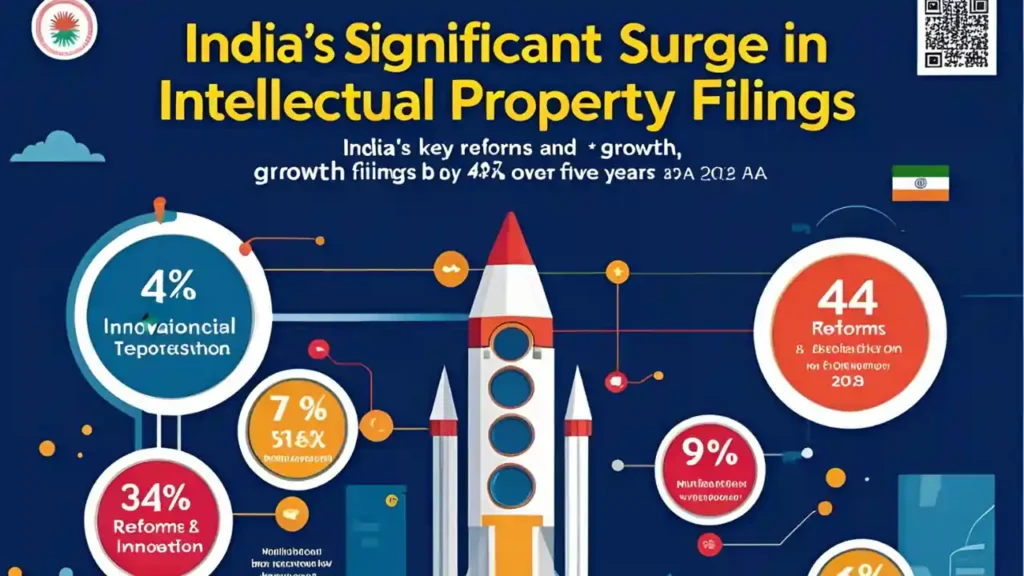New Delhi: India’s intellectual property (IP) ecosystem has undergone a remarkable transformation, with a 44% surge in IP filings from 2020–21 to 2024–25, rising from 4,77,533 to 6,89,991 applications. This significant growth, driven by strategic government reforms, digitization, and increased awareness, highlights India’s commitment to fostering innovation and protecting intellectual assets. According to a statement by the Ministry of Commerce & Industry on July 22, 2025, the most notable increase was in Geographical Indications (GIs), which soared by 380%, followed by Designs (266%), Patents (180%), Copyright (83%), Trademarks (28%), and Semiconductor Integrated Circuits Layout-Designs (SICLD) (20%).

Breakdown of IP Filings: A Five-Year Snapshot
The surge in IP filings reflects a growing emphasis on protecting creations of the mind—such as inventions, designs, literary works, and symbols—through patents, copyrights, trademarks, and GIs. Below is a detailed breakdown of IP applications filed by Indian citizens from 2020–21 to 2024–25:
- Patents: Increased from 24,326 in 2020–21 to 68,176 in 2024–25, a 180% growth.
- Designs: Rose from 10,594 to 38,804, marking a 266% increase.
- Trademarks: Grew from 4,18,594 to 5,38,665, a 28% rise.
- Copyright: Jumped from 23,957 to 44,066, an 83% increase.
- Geographical Indications (GIs): Skyrocketed from 57 to 274, a 380% surge.
- Semiconductor Integrated Circuits Layout-Designs (SICLD): Increased from 5 to 6, a 20% rise.
The total number of IP filings rose from 4,77,533 in 2020–21 to 6,89,991 in 2024–25, underscoring India’s burgeoning innovation ecosystem. The Geographical Indications category, which protects products tied to specific regions, saw the most dramatic growth, reflecting increased efforts to safeguard India’s cultural and economic heritage.
Government Initiatives Driving the IP Surge
The Indian government has implemented a slew of reforms to streamline IP processes, reduce compliance burdens, and encourage innovation, particularly among startups, MSMEs, and educational institutions. These initiatives, outlined by Shri Jitin Prasada, Minister of State for Commerce & Industry, in a Lok Sabha reply on July 22, 2025, include procedural reforms, fee concessions, digitization, and awareness programs.
Procedural Reforms for Efficiency
- Patents:
- Fixed timelines for patent grants to expedite processing.
- Mandatory electronic submission of documents by patent agents.
- Simplified requirements for priority documents and Form 27 (statement on the working of patents).
- Reduced timeline for submitting requests for examination from 48 months to 31 months.
- Frequency of filing working statements reduced from annually to once every three years.
- Streamlined foreign filing details to lower costs and simplify processes.
- Amended pre-grant opposition procedures to require a prima facie case, curbing frivolous filings.
- Extended expedited examination to applications with pre-grant oppositions for faster resolution.
- Introduced a new form to streamline claims for the Grace Period.
- Launched the Certificate of Inventorship to recognize inventors’ contributions.
- Offered a 10% fee reduction for patent renewals paid in advance electronically for at least four years.
- Trademarks:
- Replaced 74 forms with 8 consolidated forms for simplified processing.
- Established a process for determining well-known marks.
- Introduced express provisions for filing sound mark applications.
- Simplified procedures for registering Registered Users of trademarks.
- Designs:
- Streamlined application processing.
- Adopted the Locarno Agreement for international classification of industrial designs.
- Copyright:
- Reduced compliance requirements for software registration.
- Enhanced accountability and transparency of copyright societies.
- Geographical Indications:
- Simplified registration procedures for Authorized Users.
Fee Concessions for Startups, MSMEs, and Educational Institutions
To make IP protection accessible, the government introduced significant fee reductions:
- 80% reduction in patent fees for startups, MSMEs, and educational institutions.
- 75% reduction in design fees for startups and MSMEs.
- 50% reduction in trademark filing fees for startups and MSMEs.
These concessions have democratized access to IP protection, enabling smaller entities to safeguard their innovations.
Expedited Examination Provisions
To accelerate IP processing, expedited examination options have been introduced:
- Patents: Available for startups, MSMEs, female applicants, government institutions, and applicants electing India as an authority for international applications under Rule 24(C) of the Patents Rules, 2003.
- Trademarks: Expedited examination extended to all applicant categories.
Digitization and Modernization of IP Offices
The modernization of IP offices has been a cornerstone of India’s IP transformation. Key features include:
- Comprehensive E-Filing System: Over 95% of patent and trademark applications are now filed online, eliminating the need for physical visits to IP offices.
- 24×7 Accessibility: Online filing and processing systems offer secure, user-friendly interfaces with e-Sign and Digital Signature Certificate (DSC) options.
- Real-Time Tracking: Applicants can track application statuses and receive auto-generated email communications.
- Online Certificates: Patent grant certificates are delivered and downloadable online.
- Video Conferencing: Applicants can attend hearings virtually, reducing the need for in-person appearances.
- E-Processing System: Internal examination processes are digitized for efficiency.
- SMS Alerts: Real-time updates via SMS enhance user experience.
The IP Office website (ipindia.gov.in) has been revamped for better navigation and accessibility, offering login-free search facilities and real-time IP data. A publicly accessible IP Dashboard provides comprehensive data on patents, designs, trademarks, copyrights, and GIs, accessible at ipindia.gov.in/dashboard.
AI-Powered Tools and Digital Assistants
- AI-Powered Trademark Search Technology: Leverages artificial intelligence and machine learning for efficient and accurate trademark examinations.
- IP Sarthi Chatbot: A digital assistant offering instant support for IP registration queries, particularly for small businesses.
- WIPO IP Diagnostics – Indian Adaptation: A self-assessment tool in English, Bengali, Hindi, Tamil, and Urdu to help small businesses evaluate their IP assets and align with India’s IP laws.
Awareness and Outreach Programs
The National Intellectual Property Awareness Mission (NIPAM), launched in 2021, has been instrumental in spreading IP awareness. As part of Azadi Ka Amrit Mahotsav, NIPAM aimed to educate 1 million students. By 2025, it has conducted 9,500 programs across all 28 states and 8 Union Territories, reaching over 25 lakh students and faculty.
The National Intellectual Property (IP) Awards recognize top innovators, including individuals, institutions, and enterprises, fostering creativity. The IPR Internship Programme, a four-week initiative by the Office of the Controller General of Patents, Designs & Trade Marks (CGPDTM), targets students, scholars, and professionals to deepen IP expertise.
The Start-Ups Intellectual Property Protection (SIPP) Scheme, launched in 2016, provides pro bono facilitation for startups’ patent, trademark, and design applications, with the CGPDTM covering professional fees. The scheme now extends to educational institutions and international patent filings in India.
Manpower Augmentation and Grievance Redressal
To handle the growing volume of IP applications, the government has significantly increased manpower:
- Patent Office: Sanctioned strength grew by 233% (from 431 in 2014 to 1,433 in 2024), with working manpower up by 196% (from 281 to 833).
- Trademarks, GI, and Copyright: An additional 200 posts sanctioned in 2025, a 74% increase in strength.
A robust grievance redressal mechanism includes Daily Open House Conferences for direct stakeholder communication and an Open House IT Helpdesk for swift query resolution.
Geographical Indications: A Cultural and Economic Triumph
The 380% surge in GI filings reflects India’s focus on protecting indigenous products. From 2004 to 2025, 697 GIs have been registered, with 658 Indian and 39 foreign applications. The trend shows:
- 2004–2019: Steady growth, averaging 20–30 applications annually.
- 2020–21: A sharp decline due to the COVID-19 pandemic.
- 2022–24: A peak of 160 applications in 2023–24, driven by post-COVID recovery and government initiatives.
GI Applications by Goods
- Handicrafts: 366 (365 Indian, 1 foreign).
- Agricultural: 218 (all Indian).
- Manufactured: 54 (22 Indian, 32 foreign).
- Food Stuff: 56 (50 Indian, 6 foreign).
- Natural: 3 (all Indian).
State-Wise GI Distribution
The top states for GI registrations include:
- Uttar Pradesh: 76
- Tamil Nadu: 69
- Maharashtra: 52
- Karnataka: 45
- Assam: 40
- Kerala: 37
- West Bengal: 34
Other notable contributors include Gujarat (28), Odisha (26), Uttarakhand (26), and Jammu & Kashmir (24). States like Chandigarh, Haryana, Lakshadweep, Punjab, and Dadra and Nagar Haveli have no registered GIs.
Conclusion: A Bright Future for India’s IP Ecosystem
India’s 44% surge in IP filings from 2020–25 underscores its emergence as a global innovation hub. Strategic reforms, including streamlined processes, fee concessions, digitization, and awareness programs like NIPAM, have empowered startups, MSMEs, and educational institutions. The 380% growth in GIs highlights India’s commitment to preserving its cultural heritage, while advancements in patents, designs, and trademarks signal a robust innovation ecosystem. With modernized IP offices, AI-driven tools, and a focus on accessibility, India is poised to lead in intellectual property protection, fostering creativity and economic growth for years to come.
Frequently Asked Questions (FAQs)
1.What is the significance of the 44% surge in Intellectual Property (IP) filings in India from 2020–2025?
The 44% increase in IP filings, from 4,77,533 in 2020–21 to 6,89,991 in 2024–25, reflects India’s growing innovation ecosystem and commitment to protecting intellectual assets. The surge, driven by a 380% rise in Geographical Indications (GIs), 266% in Designs, and 180% in Patents, showcases the success of government reforms, digitization, and awareness initiatives in fostering creativity among startups, MSMEs, and educational institutions.
2.What are the key government reforms driving the increase in IP filings?
The Indian government has introduced procedural reforms like streamlined patent timelines, mandatory e-filing, and simplified forms (e.g., reducing trademark forms from 74 to 8). Significant fee reductions (80% for patents, 75% for designs, 50% for trademarks) for startups, MSMEs, and educational institutions, along with expedited examination provisions, have made IP protection more accessible. Digitization efforts, including a 24×7 e-filing system and AI-powered trademark search, have further enhanced efficiency.
3.Why have Geographical Indications (GIs) seen the highest growth among IP categories?
GIs have surged by 380%, from 57 filings in 2020–21 to 274 in 2024–25, due to increased awareness and government efforts to protect indigenous products tied to specific regions. Simplified registration for Authorized Users and post-COVID recovery efforts led to a peak of 160 GI applications in 2023–24. This focus helps preserve India’s cultural and economic heritage, with 697 GIs registered by 2025, including 658 Indian applications.
4.How has digitization transformed India’s IP ecosystem?
Over 95% of patent and trademark applications are now filed online through a comprehensive e-filing system offering 24×7 accessibility, real-time tracking, and e-certificates. Tools like the IP Dashboard, AI-powered trademark search, and IP Sarthi Chatbot enhance efficiency and user experience. The redesigned IP Office website (ipindia.gov.in) and virtual hearings via video conferencing further streamline processes, making IP protection more transparent and accessible.
5.What role does the National Intellectual Property Awareness Mission (NIPAM) play in this growth?
Launched in 2021, NIPAM has conducted over 9,500 IP awareness programs across all 28 states and 8 Union Territories, reaching more than 25 lakh students and faculty. By educating young innovators and institutions, NIPAM has significantly increased IP awareness, contributing to the rise in filings. Other initiatives, like the SIPP Scheme and IPR Internship Programme, further support startups and professionals in navigating IP processes.

